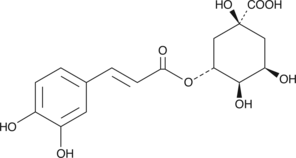Cayman
Showing 15001–15150 of 45550 results
-
Chicoric acid is a dicaffeoyl ester that has been found in C. intybus with diverse biological activities.{43186} Chicoric acid (50-200 μg/ml) dose-dependently reduces the viability of Caco-2 and HCT116 human colorectal cancer cells.{43182} It inhibits HIV integrase activities, including 3′-processing of a DNA oligonucleotide and integration with template DNA (IC50s = 1.1 and 0.8 μM, respectively).{43183} Chicoric acid (0.5-10 μM) noncompetitively inhibits integration of HIV DNA by HIV integrase and, at concentrations greater than or equal to 5 μM, inhibits HIV entry into H9 cells.{43184} Oral administration of chicoric acid (10 and 30 mg/kg) reduces hepatic lipid accumulation, lipid peroxidation, and fibrosis, inhibits production of pro-inflammatory cytokines and activation of NF-kB, and activates the AMPK signaling pathway in a mouse model of non-alcoholic steatohepatitis (NASH) induced by a methionine and choline-deficient diet.{43589} Chicoric acid (2 mg/kg) also reduces blood glucose levels by 54% in mice with streptozotocin-induced diabetes.{43185}
Brand:CaymanSKU:24960 - 50 mgAvailable on backorder
Chidamide is an inhibitor of histone deacetylases (HDACs; IC50s = 0.095, 0.160, 0.067, 0.733, 0.078, and 0.432 µM for HDAC1-3, 8, 10, and 11, respectively).{53218} It is selective for these HDACs over HDAC4-7 and 9 (IC50s = >30 µM for all). Chidamide also inhibits nicotinamide phosphoribosyltransferase (Nampt; IC50 = 2.1 µM).{50976} It inhibits cell growth in a panel of 18 cancer cell lines (GI50s = 0.4-40 µM) but has no effect on the growth of non-cancerous CCC-HEK human fetal kidney or CCC-HEL human liver cells (GI50s = >100 µM).{53218} In vivo, tucidinostat (12.5, 25, and 50 mg/kg) reduces tumor growth in HCT-8, A549, BEL-7402, and MCF-7 mouse xenograft models.{53218}
Brand:CaymanSKU:-Chidamide is an inhibitor of histone deacetylases (HDACs; IC50s = 0.095, 0.160, 0.067, 0.733, 0.078, and 0.432 µM for HDAC1-3, 8, 10, and 11, respectively).{53218} It is selective for these HDACs over HDAC4-7 and 9 (IC50s = >30 µM for all). Chidamide also inhibits nicotinamide phosphoribosyltransferase (Nampt; IC50 = 2.1 µM).{50976} It inhibits cell growth in a panel of 18 cancer cell lines (GI50s = 0.4-40 µM) but has no effect on the growth of non-cancerous CCC-HEK human fetal kidney or CCC-HEL human liver cells (GI50s = >100 µM).{53218} In vivo, tucidinostat (12.5, 25, and 50 mg/kg) reduces tumor growth in HCT-8, A549, BEL-7402, and MCF-7 mouse xenograft models.{53218}
Brand:CaymanSKU:-Chidamide is an inhibitor of histone deacetylases (HDACs; IC50s = 0.095, 0.160, 0.067, 0.733, 0.078, and 0.432 µM for HDAC1-3, 8, 10, and 11, respectively).{53218} It is selective for these HDACs over HDAC4-7 and 9 (IC50s = >30 µM for all). Chidamide also inhibits nicotinamide phosphoribosyltransferase (Nampt; IC50 = 2.1 µM).{50976} It inhibits cell growth in a panel of 18 cancer cell lines (GI50s = 0.4-40 µM) but has no effect on the growth of non-cancerous CCC-HEK human fetal kidney or CCC-HEL human liver cells (GI50s = >100 µM).{53218} In vivo, tucidinostat (12.5, 25, and 50 mg/kg) reduces tumor growth in HCT-8, A549, BEL-7402, and MCF-7 mouse xenograft models.{53218}
Brand:CaymanSKU:-Chidamide is an inhibitor of histone deacetylases (HDACs; IC50s = 0.095, 0.160, 0.067, 0.733, 0.078, and 0.432 µM for HDAC1-3, 8, 10, and 11, respectively).{53218} It is selective for these HDACs over HDAC4-7 and 9 (IC50s = >30 µM for all). Chidamide also inhibits nicotinamide phosphoribosyltransferase (Nampt; IC50 = 2.1 µM).{50976} It inhibits cell growth in a panel of 18 cancer cell lines (GI50s = 0.4-40 µM) but has no effect on the growth of non-cancerous CCC-HEK human fetal kidney or CCC-HEL human liver cells (GI50s = >100 µM).{53218} In vivo, tucidinostat (12.5, 25, and 50 mg/kg) reduces tumor growth in HCT-8, A549, BEL-7402, and MCF-7 mouse xenograft models.{53218}
Brand:CaymanSKU:-CHIR090 is an antibiotic that inhibits LpxC, a deacetylase involved in the biosynthesis of LPS lipid A, with Ki values of 1-1.7 nM in A. aeolicus.{38249} It is active against Gram-negative bacteria with MIC values of 0.05, 0.78, and 0.10-6.25 mg/ml for E. coli, P. aeruginosa, and various B. multivorans (II) strains, respectively.{38247,38248} It is comparable in strength to ciprofloxacin (Item No. 14286) in disc assays.{38249}
Brand:CaymanSKU:22256 -Out of stock
CHIR090 is an antibiotic that inhibits LpxC, a deacetylase involved in the biosynthesis of LPS lipid A, with Ki values of 1-1.7 nM in A. aeolicus.{38249} It is active against Gram-negative bacteria with MIC values of 0.05, 0.78, and 0.10-6.25 mg/ml for E. coli, P. aeruginosa, and various B. multivorans (II) strains, respectively.{38247,38248} It is comparable in strength to ciprofloxacin (Item No. 14286) in disc assays.{38249}
Brand:CaymanSKU:22256 -Out of stock
CHIR090 is an antibiotic that inhibits LpxC, a deacetylase involved in the biosynthesis of LPS lipid A, with Ki values of 1-1.7 nM in A. aeolicus.{38249} It is active against Gram-negative bacteria with MIC values of 0.05, 0.78, and 0.10-6.25 mg/ml for E. coli, P. aeruginosa, and various B. multivorans (II) strains, respectively.{38247,38248} It is comparable in strength to ciprofloxacin (Item No. 14286) in disc assays.{38249}
Brand:CaymanSKU:22256 -Out of stock
Checkpoint kinase 1 (Chk1) regulates S and G2-M phase cell cycle checkpoints in response to DNA damage. CHIR124 is a cell-permeable, quinolone-based inhibitor of Chk1 (IC50 = 0.3 nM in vitro).{27078} It demonstrates high selectivity for Chk1 by displaying inhibitory values 2,000-fold higher against Chk2 (IC50 = 0.7 µM).{27078} In synergy with topoisomerase I poisons or ionizing radiation, CHIR124 can inhibit the growth of p53-mutant solid tumor cells both in vitro and in a xenograft model, potentiating tumor apoptosis.{27078,27079}
Brand:CaymanSKU:-Out of stock
Checkpoint kinase 1 (Chk1) regulates S and G2-M phase cell cycle checkpoints in response to DNA damage. CHIR124 is a cell-permeable, quinolone-based inhibitor of Chk1 (IC50 = 0.3 nM in vitro).{27078} It demonstrates high selectivity for Chk1 by displaying inhibitory values 2,000-fold higher against Chk2 (IC50 = 0.7 µM).{27078} In synergy with topoisomerase I poisons or ionizing radiation, CHIR124 can inhibit the growth of p53-mutant solid tumor cells both in vitro and in a xenograft model, potentiating tumor apoptosis.{27078,27079}
Brand:CaymanSKU:-Out of stock
Checkpoint kinase 1 (Chk1) regulates S and G2-M phase cell cycle checkpoints in response to DNA damage. CHIR124 is a cell-permeable, quinolone-based inhibitor of Chk1 (IC50 = 0.3 nM in vitro).{27078} It demonstrates high selectivity for Chk1 by displaying inhibitory values 2,000-fold higher against Chk2 (IC50 = 0.7 µM).{27078} In synergy with topoisomerase I poisons or ionizing radiation, CHIR124 can inhibit the growth of p53-mutant solid tumor cells both in vitro and in a xenograft model, potentiating tumor apoptosis.{27078,27079}
Brand:CaymanSKU:-Out of stock
Checkpoint kinase 1 (Chk1) regulates S and G2-M phase cell cycle checkpoints in response to DNA damage. CHIR124 is a cell-permeable, quinolone-based inhibitor of Chk1 (IC50 = 0.3 nM in vitro).{27078} It demonstrates high selectivity for Chk1 by displaying inhibitory values 2,000-fold higher against Chk2 (IC50 = 0.7 µM).{27078} In synergy with topoisomerase I poisons or ionizing radiation, CHIR124 can inhibit the growth of p53-mutant solid tumor cells both in vitro and in a xenograft model, potentiating tumor apoptosis.{27078,27079}
Brand:CaymanSKU:-Out of stock
The two isoforms of glycogen synthase kinase 3, GSK3α and GSK3β, constitutively phosphorylates and inactivates glycogen synthase, preventing glycogen synthesis.{19045} They also phosphorylate proteins that are relevant to Alzheimer’s disease and osteogenesis.{25567,25565,25566} CHIR98014 is a reversible, cell-permeable inhibitor of GSK3α and GSK3β (IC50 = 0.65 and 0.58 nM, respectively).{19045} It is inactive against a series of other serine/threonine or tyrosine kinases.{19045} Through its effects on GSK3, CHIR98014 stimulates glycogen synthase in cells (EC50 = 106 nM), potentiates insulin-dependent glucose transport in isolated muscle strips, and improves glucose disposal in diabetic animals.{19045} CHIR98014 also reduces tau phosphorylation in rat brains and supports Wnt signaling during osteogenesis.{22495,25566}
Brand:CaymanSKU:-The two isoforms of glycogen synthase kinase 3, GSK3α and GSK3β, constitutively phosphorylates and inactivates glycogen synthase, preventing glycogen synthesis.{19045} They also phosphorylate proteins that are relevant to Alzheimer’s disease and osteogenesis.{25567,25565,25566} CHIR98014 is a reversible, cell-permeable inhibitor of GSK3α and GSK3β (IC50 = 0.65 and 0.58 nM, respectively).{19045} It is inactive against a series of other serine/threonine or tyrosine kinases.{19045} Through its effects on GSK3, CHIR98014 stimulates glycogen synthase in cells (EC50 = 106 nM), potentiates insulin-dependent glucose transport in isolated muscle strips, and improves glucose disposal in diabetic animals.{19045} CHIR98014 also reduces tau phosphorylation in rat brains and supports Wnt signaling during osteogenesis.{22495,25566}
Brand:CaymanSKU:-The two isoforms of glycogen synthase kinase 3, GSK3α and GSK3β, constitutively phosphorylates and inactivates glycogen synthase, preventing glycogen synthesis.{19045} They also phosphorylate proteins that are relevant to Alzheimer’s disease and osteogenesis.{25567,25565,25566} CHIR98014 is a reversible, cell-permeable inhibitor of GSK3α and GSK3β (IC50 = 0.65 and 0.58 nM, respectively).{19045} It is inactive against a series of other serine/threonine or tyrosine kinases.{19045} Through its effects on GSK3, CHIR98014 stimulates glycogen synthase in cells (EC50 = 106 nM), potentiates insulin-dependent glucose transport in isolated muscle strips, and improves glucose disposal in diabetic animals.{19045} CHIR98014 also reduces tau phosphorylation in rat brains and supports Wnt signaling during osteogenesis.{22495,25566}
Brand:CaymanSKU:-The two isoforms of glycogen synthase kinase 3, GSK3α and GSK3β, constitutively phosphorylates and inactivates glycogen synthase, preventing glycogen synthesis.{19045} They also phosphorylate proteins that are relevant to Alzheimer’s disease and osteogenesis.{25567,25565,25566} CHIR98014 is a reversible, cell-permeable inhibitor of GSK3α and GSK3β (IC50 = 0.65 and 0.58 nM, respectively).{19045} It is inactive against a series of other serine/threonine or tyrosine kinases.{19045} Through its effects on GSK3, CHIR98014 stimulates glycogen synthase in cells (EC50 = 106 nM), potentiates insulin-dependent glucose transport in isolated muscle strips, and improves glucose disposal in diabetic animals.{19045} CHIR98014 also reduces tau phosphorylation in rat brains and supports Wnt signaling during osteogenesis.{22495,25566}
Brand:CaymanSKU:-Glycogen synthase kinase 3 (GSK3) is a serine/threonine kinase that plays a key inhibitory role in both the insulin and Wnt signaling pathways.{14419,14420} CHIR99021 is an aminopyrimidine derivative that inhibits GSK3α and GSK3β with IC50 values of 10 and 6.7 nM, respectively.{19045} When tested against twenty different protein kinases, this inhibitor shows greater than 500-fold selectivity for GSK3.{19045} CHIR99021 activates glycogen synthesis in CHO-IR cells (EC50 = 0.8 μM) and in isolated type 1 diabetic rat skeletal muscle.{19045} A single oral dose (30 mg/kg) of CHIR99021 enhances in vivo glucose metabolism in a rodent model of type 2 diabetes.{19045} CHIR99021 has also been shown to induce the reprogramming of murine and human somatic cells into stem cells.{19047,16878}
Brand:CaymanSKU:-Glycogen synthase kinase 3 (GSK3) is a serine/threonine kinase that plays a key inhibitory role in both the insulin and Wnt signaling pathways.{14419,14420} CHIR99021 is an aminopyrimidine derivative that inhibits GSK3α and GSK3β with IC50 values of 10 and 6.7 nM, respectively.{19045} When tested against twenty different protein kinases, this inhibitor shows greater than 500-fold selectivity for GSK3.{19045} CHIR99021 activates glycogen synthesis in CHO-IR cells (EC50 = 0.8 μM) and in isolated type 1 diabetic rat skeletal muscle.{19045} A single oral dose (30 mg/kg) of CHIR99021 enhances in vivo glucose metabolism in a rodent model of type 2 diabetes.{19045} CHIR99021 has also been shown to induce the reprogramming of murine and human somatic cells into stem cells.{19047,16878}
Brand:CaymanSKU:-Glycogen synthase kinase 3 (GSK3) is a serine/threonine kinase that plays a key inhibitory role in both the insulin and Wnt signaling pathways.{14419,14420} CHIR99021 is an aminopyrimidine derivative that inhibits GSK3α and GSK3β with IC50 values of 10 and 6.7 nM, respectively.{19045} When tested against twenty different protein kinases, this inhibitor shows greater than 500-fold selectivity for GSK3.{19045} CHIR99021 activates glycogen synthesis in CHO-IR cells (EC50 = 0.8 μM) and in isolated type 1 diabetic rat skeletal muscle.{19045} A single oral dose (30 mg/kg) of CHIR99021 enhances in vivo glucose metabolism in a rodent model of type 2 diabetes.{19045} CHIR99021 has also been shown to induce the reprogramming of murine and human somatic cells into stem cells.{19047,16878}
Brand:CaymanSKU:-Glycogen synthase kinase 3 (GSK3) is a serine/threonine kinase that plays a key inhibitory role in both the insulin and Wnt signaling pathways.{14419,14420} CHIR99021 is an aminopyrimidine derivative that inhibits GSK3α and GSK3β with IC50 values of 10 and 6.7 nM, respectively.{19045} When tested against twenty different protein kinases, this inhibitor shows greater than 500-fold selectivity for GSK3.{19045} CHIR99021 activates glycogen synthesis in CHO-IR cells (EC50 = 0.8 μM) and in isolated type 1 diabetic rat skeletal muscle.{19045} A single oral dose (30 mg/kg) of CHIR99021 enhances in vivo glucose metabolism in a rodent model of type 2 diabetes.{19045} CHIR99021 has also been shown to induce the reprogramming of murine and human somatic cells into stem cells.{19047,16878}
Brand:CaymanSKU:-Chitobiose is a dimer of β-1,4 linked glucosamine units derived from chitin, which, in turn, is a long chain polymer of N-acetylglucosamine that is a primary component of fungal cell walls and arthropod exoskeletons. Chitobiose octaacetate is a form of chitobiose containing eight acetate groups. It is formed by the acetolysis of chitin. Chitobiose octaacetate can be used for the synthesis of chitobiose oxazoline and other chitin precursors.
Brand:CaymanSKU:-Out of stock
Chitobiose is a dimer of β-1,4 linked glucosamine units derived from chitin, which, in turn, is a long chain polymer of N-acetylglucosamine that is a primary component of fungal cell walls and arthropod exoskeletons. Chitobiose octaacetate is a form of chitobiose containing eight acetate groups. It is formed by the acetolysis of chitin. Chitobiose octaacetate can be used for the synthesis of chitobiose oxazoline and other chitin precursors.
Brand:CaymanSKU:-Out of stock
Chitobiose is a dimer of β-1,4 linked glucosamine units derived from chitin, which, in turn, is a long chain polymer of N-acetylglucosamine that is a primary component of fungal cell walls and arthropod exoskeletons. Chitobiose octaacetate is a form of chitobiose containing eight acetate groups. It is formed by the acetolysis of chitin. Chitobiose octaacetate can be used for the synthesis of chitobiose oxazoline and other chitin precursors.
Brand:CaymanSKU:-Out of stock
Chitobiose is a dimer of β-1,4 linked glucosamine units derived from chitin, which, in turn, is a long chain polymer of N-acetylglucosamine that is a primary component of fungal cell walls and arthropod exoskeletons. Chitobiose octaacetate is a form of chitobiose containing eight acetate groups. It is formed by the acetolysis of chitin. Chitobiose octaacetate can be used for the synthesis of chitobiose oxazoline and other chitin precursors.
Brand:CaymanSKU:-Out of stock
Chk2 inhibitor is an inhibitor of checkpoint kinase 2 (Chk2; IC50 = 13.5 nM).{48513} It is selective for Chk2 over Chk1 (IC50 = 220.4 nM). It inhibits Chk2 autophosphorylation at the serine in position 516 in non-cancerous 184B5 cells that contain wild-type p53 and in MDA-MB-231 cells that contain mutated p53 when used at concentrations ranging from 0.1 to 30 µM. Chk2 inhibitor enhances survival of 184B5, but not MDA-MB-231, cells following ionizing radiation and inhibits cell cycle arrest at the G2 stage induced by ionizing radiation in 184B5 cells. It also inhibits the production of IL-2 in Jurkat cells stimulated by phorbol 12-myristate 13-acetate (PMA; Item No. 10008014) and the production of TNF-α in LPS-stimulated THP-1 cells (IC50s = 3.5 and 8.2 µM, respectively).{48514} Chk2 inhibitor also inhibits the growth of CEM leukemia T cells (GI50 = 1.73 µM).
Brand:CaymanSKU:21184 -Out of stock
Chk2 inhibitor is an inhibitor of checkpoint kinase 2 (Chk2; IC50 = 13.5 nM).{48513} It is selective for Chk2 over Chk1 (IC50 = 220.4 nM). It inhibits Chk2 autophosphorylation at the serine in position 516 in non-cancerous 184B5 cells that contain wild-type p53 and in MDA-MB-231 cells that contain mutated p53 when used at concentrations ranging from 0.1 to 30 µM. Chk2 inhibitor enhances survival of 184B5, but not MDA-MB-231, cells following ionizing radiation and inhibits cell cycle arrest at the G2 stage induced by ionizing radiation in 184B5 cells. It also inhibits the production of IL-2 in Jurkat cells stimulated by phorbol 12-myristate 13-acetate (PMA; Item No. 10008014) and the production of TNF-α in LPS-stimulated THP-1 cells (IC50s = 3.5 and 8.2 µM, respectively).{48514} Chk2 inhibitor also inhibits the growth of CEM leukemia T cells (GI50 = 1.73 µM).
Brand:CaymanSKU:21184 -Out of stock
Chk2 inhibitor II is a selective, ATP-competitive inhibitor of the DNA damage control kinase, checkpoint kinase 2 (IC50 = 15 nM).{28503} It has been shown to prevent apoptosis in human T-cells exposed to ionizing radiation (EC50 = 3-7.6 µM).{28503} This compound has been used to target the role of Chk2 in cellular signaling in response to DNA damage.{28504}
Brand:CaymanSKU:-Available on backorder
Chk2 inhibitor II is a selective, ATP-competitive inhibitor of the DNA damage control kinase, checkpoint kinase 2 (IC50 = 15 nM).{28503} It has been shown to prevent apoptosis in human T-cells exposed to ionizing radiation (EC50 = 3-7.6 µM).{28503} This compound has been used to target the role of Chk2 in cellular signaling in response to DNA damage.{28504}
Brand:CaymanSKU:-Available on backorder
Chk2 inhibitor II is a selective, ATP-competitive inhibitor of the DNA damage control kinase, checkpoint kinase 2 (IC50 = 15 nM).{28503} It has been shown to prevent apoptosis in human T-cells exposed to ionizing radiation (EC50 = 3-7.6 µM).{28503} This compound has been used to target the role of Chk2 in cellular signaling in response to DNA damage.{28504}
Brand:CaymanSKU:-Available on backorder
Chlamydocin is a histone deacetylase (HDAC) inhibitor that was originally isolated from D. chlamydosporia and has anticancer properties.{49276} It is selective for HDAC1 over HDAC6 (IC50 = 0.15 and 1,100 nM, respectively).{49277} Chlamydocin increases acetylation of histone H3 and histone H4 in A2780 cells when used at concentrations ranging from 1 to 1,000 nM.{49276} It inhibits growth of A2780, Malme-3M, MCF-7, HT-29, and HeLa cancer cells (IC50s = 0.36, 45, 5.3, 4.3, and 14 nM, respectively). Chlamydocin increases lifespan by 10% in a P185 mouse allograft model when administered at doses ranging from 20 to 160 mg/kg.{49278}
Brand:CaymanSKU:28468 - 1 mgAvailable on backorder
Chlorambucil is a nitrogen mustard alkylating agent that forms intra- and interstrand crosslinks in DNA, the latter of which prevents DNA replication and transcription leading to cell death.{36302} It preferentially decreases survival of rapidly proliferating spleen colony-forming cells over spleen colony-forming cells from normal bone marrow.{36301} Formulations containing chlorambucil have been used alone and in combination with other chemotherapeutic agents in the treatment of chronic lymphocytic leukemia and lymphomas.
Brand:CaymanSKU:23744 - 1 gAvailable on backorder
Chlorambucil is a nitrogen mustard alkylating agent that forms intra- and interstrand crosslinks in DNA, the latter of which prevents DNA replication and transcription leading to cell death.{36302} It preferentially decreases survival of rapidly proliferating spleen colony-forming cells over spleen colony-forming cells from normal bone marrow.{36301} Formulations containing chlorambucil have been used alone and in combination with other chemotherapeutic agents in the treatment of chronic lymphocytic leukemia and lymphomas.
Brand:CaymanSKU:23744 - 250 mgAvailable on backorder
Chlorambucil is a nitrogen mustard alkylating agent that forms intra- and interstrand crosslinks in DNA, the latter of which prevents DNA replication and transcription leading to cell death.{36302} It preferentially decreases survival of rapidly proliferating spleen colony-forming cells over spleen colony-forming cells from normal bone marrow.{36301} Formulations containing chlorambucil have been used alone and in combination with other chemotherapeutic agents in the treatment of chronic lymphocytic leukemia and lymphomas.
Brand:CaymanSKU:23744 - 500 mgAvailable on backorder
Chloramine-T is a common reagent in a variety of synthetic processes.{52486} It has been used as a reagent in aminohydroxylation and allylic amination reactions, as a nitrogen source for the aziridination of alkenes and olefins, and in the deprotection of thio groups in sulfur-containing compounds, among others. It has been used as a reagent in the synthesis of Factor Xa inhibitors.{52487} Chloramine-T (0.2% w/v) is also an antiseptic agent that is bactericidal against S. epidermidis, S. aureus, E. faecalis, E. coli, P. mirabilis, and E. cloacae.{52488}
Brand:CaymanSKU:30533 - 10 gAvailable on backorder
Chloramine-T is a common reagent in a variety of synthetic processes.{52486} It has been used as a reagent in aminohydroxylation and allylic amination reactions, as a nitrogen source for the aziridination of alkenes and olefins, and in the deprotection of thio groups in sulfur-containing compounds, among others. It has been used as a reagent in the synthesis of Factor Xa inhibitors.{52487} Chloramine-T (0.2% w/v) is also an antiseptic agent that is bactericidal against S. epidermidis, S. aureus, E. faecalis, E. coli, P. mirabilis, and E. cloacae.{52488}
Brand:CaymanSKU:30533 - 25 gAvailable on backorder
Chloramine-T is a common reagent in a variety of synthetic processes.{52486} It has been used as a reagent in aminohydroxylation and allylic amination reactions, as a nitrogen source for the aziridination of alkenes and olefins, and in the deprotection of thio groups in sulfur-containing compounds, among others. It has been used as a reagent in the synthesis of Factor Xa inhibitors.{52487} Chloramine-T (0.2% w/v) is also an antiseptic agent that is bactericidal against S. epidermidis, S. aureus, E. faecalis, E. coli, P. mirabilis, and E. cloacae.{52488}
Brand:CaymanSKU:30533 - 5 gAvailable on backorder
Chloramphenicol acetate is an acetylated and inactive version of chloramphenicol.{38446} It is formed in E. coli and S. aureus by the inducible enzyme chloramphenicol acetyltransferase in the presence of acetyl coenzyme A (acetyl-CoA; Item No. 16160) to confer chloramphenicol resistance. Chloramphenicol acetate has no antibiotic activity against S. sonnei in a turbidimetric assay.
Brand:CaymanSKU:23811 - 25 mgAvailable on backorder
Chloramphenicol acetate is an acetylated and inactive version of chloramphenicol.{38446} It is formed in E. coli and S. aureus by the inducible enzyme chloramphenicol acetyltransferase in the presence of acetyl coenzyme A (acetyl-CoA; Item No. 16160) to confer chloramphenicol resistance. Chloramphenicol acetate has no antibiotic activity against S. sonnei in a turbidimetric assay.
Brand:CaymanSKU:23811 - 5 mgAvailable on backorder
Chloramphenicol palmitate is an orally bioavailable ester prodrug form of the antibiotic chloramphenicol.{42594} It is hydrolyzed in the small intestine to release chloramphenicol. Formulations containing chloramphenicol palmitate were previously used in the treatment of severe bacterial infections.
Brand:CaymanSKU:26663 - 25 mgAvailable on backorder
Chloramphenicol palmitate is an orally bioavailable ester prodrug form of the antibiotic chloramphenicol.{42594} It is hydrolyzed in the small intestine to release chloramphenicol. Formulations containing chloramphenicol palmitate were previously used in the treatment of severe bacterial infections.
Brand:CaymanSKU:26663 - 5 mgAvailable on backorder
Chloramphenicol succinate is a water-soluble prodrug form of the antibiotic chloramphenicol.{36717} It is a substrate for succinate dehydrogenase (SDH) and is oxidized by human liver and rat liver and kidney mitochondria to release chloramphenicol in vitro.{36718} Chloramphenicol succinate reduces human leukocyte migration in vitro.{36719} In vivo, chloramphenicol succinate reduces E. coli growth in rabbit and rat models of pyelonephritis when administered at doses of 150 and 200 mg/kg, respectively.{36720} Chloramphenicol succinate (20 mg/kg) reduces infarct size in a porcine model of myocardial ischemia-reperfusion injury.{36721} Formulations containing chloramphenicol succinate have been used in the treatment of severe bacterial infections.
Brand:CaymanSKU:25453 - 25 mgAvailable on backorder
Chloramphenicol succinate is a water-soluble prodrug form of the antibiotic chloramphenicol.{36717} It is a substrate for succinate dehydrogenase (SDH) and is oxidized by human liver and rat liver and kidney mitochondria to release chloramphenicol in vitro.{36718} Chloramphenicol succinate reduces human leukocyte migration in vitro.{36719} In vivo, chloramphenicol succinate reduces E. coli growth in rabbit and rat models of pyelonephritis when administered at doses of 150 and 200 mg/kg, respectively.{36720} Chloramphenicol succinate (20 mg/kg) reduces infarct size in a porcine model of myocardial ischemia-reperfusion injury.{36721} Formulations containing chloramphenicol succinate have been used in the treatment of severe bacterial infections.
Brand:CaymanSKU:25453 - 5 mgAvailable on backorder
Chlorantraniliprole is an anthranilic diamide insecticide and agonist of ryanodine receptors located on the sarcoplasmic reticulum in muscle and endoplasmic reticulum in non-muscle cells.{43108} It binds to a different site than ryanodine on the receptor and stimulates the release of calcium from intracellular stores with EC50 values ranging from 40 to 50 nM for P. americana neurons and H. virescens or D. melanogaster recombinant ryanodine receptors. It is highly selective for insect over mammalian ryanodine receptors (EC50s = 14,000 nM, >100 µM, and >100 µM for C2C12 mouse, PC12 rat, and IMR32 human cells, respectively).{43109} Chlorantraniliprole is active against insects of the order Lepidoptera, including larvae of the fall armyworm (S. frugiperda), diamondback moth (P. xylostella), and tobacco budworm (H. virescens) with EC50 values of 0.02, 0.01, and 0.05 ppm, respectively, and of the orders Coleoptera, Diptera, and Isoptera. Formulations containing chlorantraniliprole have been used in agriculture to control moths, beetles, and caterpillars among other insects.
Brand:CaymanSKU:24140 - 10 mgAvailable on backorder
Chlorantraniliprole is an anthranilic diamide insecticide and agonist of ryanodine receptors located on the sarcoplasmic reticulum in muscle and endoplasmic reticulum in non-muscle cells.{43108} It binds to a different site than ryanodine on the receptor and stimulates the release of calcium from intracellular stores with EC50 values ranging from 40 to 50 nM for P. americana neurons and H. virescens or D. melanogaster recombinant ryanodine receptors. It is highly selective for insect over mammalian ryanodine receptors (EC50s = 14,000 nM, >100 µM, and >100 µM for C2C12 mouse, PC12 rat, and IMR32 human cells, respectively).{43109} Chlorantraniliprole is active against insects of the order Lepidoptera, including larvae of the fall armyworm (S. frugiperda), diamondback moth (P. xylostella), and tobacco budworm (H. virescens) with EC50 values of 0.02, 0.01, and 0.05 ppm, respectively, and of the orders Coleoptera, Diptera, and Isoptera. Formulations containing chlorantraniliprole have been used in agriculture to control moths, beetles, and caterpillars among other insects.
Brand:CaymanSKU:24140 - 25 mgAvailable on backorder
Chlorantraniliprole is an anthranilic diamide insecticide and agonist of ryanodine receptors located on the sarcoplasmic reticulum in muscle and endoplasmic reticulum in non-muscle cells.{43108} It binds to a different site than ryanodine on the receptor and stimulates the release of calcium from intracellular stores with EC50 values ranging from 40 to 50 nM for P. americana neurons and H. virescens or D. melanogaster recombinant ryanodine receptors. It is highly selective for insect over mammalian ryanodine receptors (EC50s = 14,000 nM, >100 µM, and >100 µM for C2C12 mouse, PC12 rat, and IMR32 human cells, respectively).{43109} Chlorantraniliprole is active against insects of the order Lepidoptera, including larvae of the fall armyworm (S. frugiperda), diamondback moth (P. xylostella), and tobacco budworm (H. virescens) with EC50 values of 0.02, 0.01, and 0.05 ppm, respectively, and of the orders Coleoptera, Diptera, and Isoptera. Formulations containing chlorantraniliprole have been used in agriculture to control moths, beetles, and caterpillars among other insects.
Brand:CaymanSKU:24140 - 5 mgAvailable on backorder
Chlorantraniliprole is an anthranilic diamide insecticide and agonist of ryanodine receptors located on the sarcoplasmic reticulum in muscle and endoplasmic reticulum in non-muscle cells.{43108} It binds to a different site than ryanodine on the receptor and stimulates the release of calcium from intracellular stores with EC50 values ranging from 40 to 50 nM for P. americana neurons and H. virescens or D. melanogaster recombinant ryanodine receptors. It is highly selective for insect over mammalian ryanodine receptors (EC50s = 14,000 nM, >100 µM, and >100 µM for C2C12 mouse, PC12 rat, and IMR32 human cells, respectively).{43109} Chlorantraniliprole is active against insects of the order Lepidoptera, including larvae of the fall armyworm (S. frugiperda), diamondback moth (P. xylostella), and tobacco budworm (H. virescens) with EC50 values of 0.02, 0.01, and 0.05 ppm, respectively, and of the orders Coleoptera, Diptera, and Isoptera. Formulations containing chlorantraniliprole have been used in agriculture to control moths, beetles, and caterpillars among other insects.
Brand:CaymanSKU:24140 - 50 mgAvailable on backorder
Chlorcyclizine is a phenylpiperazine that acts as a histamine H1 receptor antagonist (Ki = 9 nM).{23220} It has also been shown to be effective against hepatitis C virus (HCV; EC50 = 44 nM in vitro), preventing viral entry into host cells.{30619} In chimeric mice engrafted with primary human hepatocytes, 10-50 mg/kg chlorcyclizine significantly inhibited infection of HCV genotypes 1b and 2a.{30619}
Brand:CaymanSKU:-Available on backorder
Chlorcyclizine is a phenylpiperazine that acts as a histamine H1 receptor antagonist (Ki = 9 nM).{23220} It has also been shown to be effective against hepatitis C virus (HCV; EC50 = 44 nM in vitro), preventing viral entry into host cells.{30619} In chimeric mice engrafted with primary human hepatocytes, 10-50 mg/kg chlorcyclizine significantly inhibited infection of HCV genotypes 1b and 2a.{30619}
Brand:CaymanSKU:-Available on backorder
Chlorcyclizine is a phenylpiperazine that acts as a histamine H1 receptor antagonist (Ki = 9 nM).{23220} It has also been shown to be effective against hepatitis C virus (HCV; EC50 = 44 nM in vitro), preventing viral entry into host cells.{30619} In chimeric mice engrafted with primary human hepatocytes, 10-50 mg/kg chlorcyclizine significantly inhibited infection of HCV genotypes 1b and 2a.{30619}
Brand:CaymanSKU:-Available on backorder
Chlorcyclizine is a phenylpiperazine that acts as a histamine H1 receptor antagonist (Ki = 9 nM).{23220} It has also been shown to be effective against hepatitis C virus (HCV; EC50 = 44 nM in vitro), preventing viral entry into host cells.{30619} In chimeric mice engrafted with primary human hepatocytes, 10-50 mg/kg chlorcyclizine significantly inhibited infection of HCV genotypes 1b and 2a.{30619}
Brand:CaymanSKU:-Available on backorder
Chlorfenapyr is a pyrrole pro-insecticide that is metabolized in vivo into CL 303268 by mixed function oxidases.{37590} Chlorfenapyr increases respiratory activity in German cockroaches when used at concentrations ranging from 1 to 10 µg per insect but has no effect on respiration in Sf9 cells when used at concentrations ranging from 1 to 100 µM and does not affect respiration in isolated rat liver mitochondria up to a concentration of 10 µM. Chlorfenapyr is active against a variety of insects including those susceptible and resistant to pyrethroid and organophosphate insecticides, including horn flies (H. irritans) as well as A. culicifacies and A. stephensi mosquitos that carry malaria (LC50s = 2-2.39% suspension impregnated on paper).{37591,37592} Chlorfenapyr is lethal to rats with LD50 values of 441 and 1,152 mg/kg for male and female rats, respectively.{37590} Formulations containing chlorfenapyr have been used to control termites and in agriculture to control various insects.
Brand:CaymanSKU:24141 - 100 mgAvailable on backorder
Chlorfenapyr is a pyrrole pro-insecticide that is metabolized in vivo into CL 303268 by mixed function oxidases.{37590} Chlorfenapyr increases respiratory activity in German cockroaches when used at concentrations ranging from 1 to 10 µg per insect but has no effect on respiration in Sf9 cells when used at concentrations ranging from 1 to 100 µM and does not affect respiration in isolated rat liver mitochondria up to a concentration of 10 µM. Chlorfenapyr is active against a variety of insects including those susceptible and resistant to pyrethroid and organophosphate insecticides, including horn flies (H. irritans) as well as A. culicifacies and A. stephensi mosquitos that carry malaria (LC50s = 2-2.39% suspension impregnated on paper).{37591,37592} Chlorfenapyr is lethal to rats with LD50 values of 441 and 1,152 mg/kg for male and female rats, respectively.{37590} Formulations containing chlorfenapyr have been used to control termites and in agriculture to control various insects.
Brand:CaymanSKU:24141 - 50 mgAvailable on backorder
Chlorhexidine is a bis(biguanide) antimicrobial disinfectant and antiseptic agent.{47176} It inhibits growth of clinical methicillin-resistant S. aureus (MRSA) isolates (MIC90 = 4 μg/ml).{47177} It is also active against canine isolates of MRSA, methicillin-susceptible S. aureus (MSSA), methicillin-resistant S. pseudintermedius (MRSP), and methicillin-susceptible S. pseudintermedius (MSSP; MIC90s = 4, 2, 2, and 1 mg/L, respectively).{47178} Chlorhexidine inhibits growth of E. faecium strains (MICs = 1.2-19.6 μg/ml) and C. albicans (MIC = 5.15 μg/ml).{47179,47180} It generates cations that bind to and destabilize the bacterial cell wall to induce death.{47181} Chlorhexidine also completely inhibits matrix metalloproteinase-2 (MMP-2) and MMP-9 when used at concentrations of 0.0001 and 0.002%, respectively, in a gelatin degradation assay.{28418} Formulations containing chlorhexidine have been used in antiseptic wound dressings, mouthwash, and toothpaste.
Brand:CaymanSKU:26924 - 10 gAvailable on backorder
Chlorhexidine is a bis(biguanide) antimicrobial disinfectant and antiseptic agent.{47176} It inhibits growth of clinical methicillin-resistant S. aureus (MRSA) isolates (MIC90 = 4 μg/ml).{47177} It is also active against canine isolates of MRSA, methicillin-susceptible S. aureus (MSSA), methicillin-resistant S. pseudintermedius (MRSP), and methicillin-susceptible S. pseudintermedius (MSSP; MIC90s = 4, 2, 2, and 1 mg/L, respectively).{47178} Chlorhexidine inhibits growth of E. faecium strains (MICs = 1.2-19.6 μg/ml) and C. albicans (MIC = 5.15 μg/ml).{47179,47180} It generates cations that bind to and destabilize the bacterial cell wall to induce death.{47181} Chlorhexidine also completely inhibits matrix metalloproteinase-2 (MMP-2) and MMP-9 when used at concentrations of 0.0001 and 0.002%, respectively, in a gelatin degradation assay.{28418} Formulations containing chlorhexidine have been used in antiseptic wound dressings, mouthwash, and toothpaste.
Brand:CaymanSKU:26924 - 25 gAvailable on backorder
Chlorhexidine is a bis(biguanide) antimicrobial disinfectant and antiseptic agent.{47176} It inhibits growth of clinical methicillin-resistant S. aureus (MRSA) isolates (MIC90 = 4 μg/ml).{47177} It is also active against canine isolates of MRSA, methicillin-susceptible S. aureus (MSSA), methicillin-resistant S. pseudintermedius (MRSP), and methicillin-susceptible S. pseudintermedius (MSSP; MIC90s = 4, 2, 2, and 1 mg/L, respectively).{47178} Chlorhexidine inhibits growth of E. faecium strains (MICs = 1.2-19.6 μg/ml) and C. albicans (MIC = 5.15 μg/ml).{47179,47180} It generates cations that bind to and destabilize the bacterial cell wall to induce death.{47181} Chlorhexidine also completely inhibits matrix metalloproteinase-2 (MMP-2) and MMP-9 when used at concentrations of 0.0001 and 0.002%, respectively, in a gelatin degradation assay.{28418} Formulations containing chlorhexidine have been used in antiseptic wound dressings, mouthwash, and toothpaste.
Brand:CaymanSKU:26924 - 5 gAvailable on backorder
Chlorhexidine (CHX) is an antimicrobial agent often used in antiseptics and dental products such as toothpaste and mouthwash. CHX completely inhibits matrix metalloproteinases (MMP) -2 and -9 at concentrations of 0.0001% and 0.002%, respectively, in a gelatin degradation assay.{28418} Inhibition of collagen degradation by MMP-8 is completely inhibited by CHX at a concentration of 0.01%. Addition of calcium to the MMP assays prevented inhibition, suggesting that CHX may act via a cation-chelating mechanism.{28418}
Brand:CaymanSKU:-Available on backorder
Chlorhexidine (CHX) is an antimicrobial agent often used in antiseptics and dental products such as toothpaste and mouthwash. CHX completely inhibits matrix metalloproteinases (MMP) -2 and -9 at concentrations of 0.0001% and 0.002%, respectively, in a gelatin degradation assay.{28418} Inhibition of collagen degradation by MMP-8 is completely inhibited by CHX at a concentration of 0.01%. Addition of calcium to the MMP assays prevented inhibition, suggesting that CHX may act via a cation-chelating mechanism.{28418}
Brand:CaymanSKU:-Available on backorder
Chlorhexidine (CHX) is an antimicrobial agent often used in antiseptics and dental products such as toothpaste and mouthwash. CHX completely inhibits matrix metalloproteinases (MMP) -2 and -9 at concentrations of 0.0001% and 0.002%, respectively, in a gelatin degradation assay.{28418} Inhibition of collagen degradation by MMP-8 is completely inhibited by CHX at a concentration of 0.01%. Addition of calcium to the MMP assays prevented inhibition, suggesting that CHX may act via a cation-chelating mechanism.{28418}
Brand:CaymanSKU:-Available on backorder
Chlorhexidine (CHX) is an antimicrobial agent often used in antiseptics and dental products such as toothpaste and mouthwash. CHX completely inhibits matrix metalloproteinases (MMP) -2 and -9 at concentrations of 0.0001% and 0.002%, respectively, in a gelatin degradation assay.{28418} Inhibition of collagen degradation by MMP-8 is completely inhibited by CHX at a concentration of 0.01%. Addition of calcium to the MMP assays prevented inhibition, suggesting that CHX may act via a cation-chelating mechanism.{28418}
Brand:CaymanSKU:-Available on backorder
Chlorido[N,N’-disalicylidene-1,2-phenylenediamine]iron(III) is an inducer of ferroptosis.{50243} It induces ferroptosis, but not apoptosis or necroptosis, in NB1 cancer cells when used at a concentration of 3 µM.{50243} Chlorido[N,N’-disalicylidene-1,2-phenylenediamine]iron(III) inhibits proliferation of BJAB, NALM-6, Jurkat, MelHO, and MCF-7 cancer cells (IC50s = 0.07, 2.5, 1.5, 3, and 5 µM, respectively), as well as NALM-6 cells resistant to daunorubicin (Item No. 14159) and vincristine (Item No. 11764) when used at concentrations ranging from 0.04 to 0.125 µM.{45533}
Brand:CaymanSKU:28788 - 10 mgAvailable on backorder
Chlorido[N,N’-disalicylidene-1,2-phenylenediamine]iron(III) is an inducer of ferroptosis.{50243} It induces ferroptosis, but not apoptosis or necroptosis, in NB1 cancer cells when used at a concentration of 3 µM.{50243} Chlorido[N,N’-disalicylidene-1,2-phenylenediamine]iron(III) inhibits proliferation of BJAB, NALM-6, Jurkat, MelHO, and MCF-7 cancer cells (IC50s = 0.07, 2.5, 1.5, 3, and 5 µM, respectively), as well as NALM-6 cells resistant to daunorubicin (Item No. 14159) and vincristine (Item No. 11764) when used at concentrations ranging from 0.04 to 0.125 µM.{45533}
Brand:CaymanSKU:28788 - 100 mgAvailable on backorder
Chlorido[N,N’-disalicylidene-1,2-phenylenediamine]iron(III) is an inducer of ferroptosis.{50243} It induces ferroptosis, but not apoptosis or necroptosis, in NB1 cancer cells when used at a concentration of 3 µM.{50243} Chlorido[N,N’-disalicylidene-1,2-phenylenediamine]iron(III) inhibits proliferation of BJAB, NALM-6, Jurkat, MelHO, and MCF-7 cancer cells (IC50s = 0.07, 2.5, 1.5, 3, and 5 µM, respectively), as well as NALM-6 cells resistant to daunorubicin (Item No. 14159) and vincristine (Item No. 11764) when used at concentrations ranging from 0.04 to 0.125 µM.{45533}
Brand:CaymanSKU:28788 - 5 mgAvailable on backorder
Chlorido[N,N’-disalicylidene-1,2-phenylenediamine]iron(III) is an inducer of ferroptosis.{50243} It induces ferroptosis, but not apoptosis or necroptosis, in NB1 cancer cells when used at a concentration of 3 µM.{50243} Chlorido[N,N’-disalicylidene-1,2-phenylenediamine]iron(III) inhibits proliferation of BJAB, NALM-6, Jurkat, MelHO, and MCF-7 cancer cells (IC50s = 0.07, 2.5, 1.5, 3, and 5 µM, respectively), as well as NALM-6 cells resistant to daunorubicin (Item No. 14159) and vincristine (Item No. 11764) when used at concentrations ranging from 0.04 to 0.125 µM.{45533}
Brand:CaymanSKU:28788 - 50 mgAvailable on backorder
Chlorin e6 (Ce6) is a second-generation photosensitizer with antitumor activity when used in conjunction with irradiation. In a mouse model of implanted fibrosarcoma, Ce6 (2.5-10 mg/kg, i.v. with irradiation at 50-200 J/cm2) led to complete tumor loss following varying levels of irradiation.{33795} A formulation including Ce6 was tested in a Phase I clinical study for patients with bronchogenic early superficial squamous cell carcinoma with positive results (40 mg/m2, i.v. with laser irradiation at 100 J/cm2).{33832} The same dosing paradigm in a Phase II clinical trial for early stage lung cancer patients led to a complete response in 82.9% of patients.{33794} Ce6 has been examined as a nanotechnology drug delivery tool.{33793}
Brand:CaymanSKU:21684 -Out of stock
Chlorin e6 (Ce6) is a second-generation photosensitizer with antitumor activity when used in conjunction with irradiation. In a mouse model of implanted fibrosarcoma, Ce6 (2.5-10 mg/kg, i.v. with irradiation at 50-200 J/cm2) led to complete tumor loss following varying levels of irradiation.{33795} A formulation including Ce6 was tested in a Phase I clinical study for patients with bronchogenic early superficial squamous cell carcinoma with positive results (40 mg/m2, i.v. with laser irradiation at 100 J/cm2).{33832} The same dosing paradigm in a Phase II clinical trial for early stage lung cancer patients led to a complete response in 82.9% of patients.{33794} Ce6 has been examined as a nanotechnology drug delivery tool.{33793}
Brand:CaymanSKU:21684 -Out of stock
Chlorin e6 (Ce6) is a second-generation photosensitizer with antitumor activity when used in conjunction with irradiation. In a mouse model of implanted fibrosarcoma, Ce6 (2.5-10 mg/kg, i.v. with irradiation at 50-200 J/cm2) led to complete tumor loss following varying levels of irradiation.{33795} A formulation including Ce6 was tested in a Phase I clinical study for patients with bronchogenic early superficial squamous cell carcinoma with positive results (40 mg/m2, i.v. with laser irradiation at 100 J/cm2).{33832} The same dosing paradigm in a Phase II clinical trial for early stage lung cancer patients led to a complete response in 82.9% of patients.{33794} Ce6 has been examined as a nanotechnology drug delivery tool.{33793}
Brand:CaymanSKU:21684 -Out of stock
Chlorin e6 (Ce6) is a second-generation photosensitizer with antitumor activity when used in conjunction with irradiation. In a mouse model of implanted fibrosarcoma, Ce6 (2.5-10 mg/kg, i.v. with irradiation at 50-200 J/cm2) led to complete tumor loss following varying levels of irradiation.{33795} A formulation including Ce6 was tested in a Phase I clinical study for patients with bronchogenic early superficial squamous cell carcinoma with positive results (40 mg/m2, i.v. with laser irradiation at 100 J/cm2).{33832} The same dosing paradigm in a Phase II clinical trial for early stage lung cancer patients led to a complete response in 82.9% of patients.{33794} Ce6 has been examined as a nanotechnology drug delivery tool.{33793}
Brand:CaymanSKU:21684 -Out of stock
Chlorisondamine is an antagonist of nicotinic acetylcholine receptors (nAChRs; IC50 = 1.8 µM in rat striatal synaptosomes) and a ganglion blocker.{38466} It decreases dopamine release induced by nicotine (Item Nos. 16535 | 20887) in a dose-dependent manner in rat striatal synaptosomes at concentrations ranging from 0-100 µM. The effect of chlorisondamine is long-lasting, with a 10 mg/kg dose blocking nicotine-induced stimulant activity for at least five weeks.{38463} Chlorisondamine (5 µg, i.c.v.) prevents rats from acquiring a (–)-nicotine-induced conditioned taste aversion response, a model of the aversive effects of nicotine.{38465} It also inhibits autonomic ganglia, providing approximately 50% inhibition of the contractile response in feline superior cervical ganglion nictitating membrane preparations when administered at a dose of 50 mg/kg.{38464}
Brand:CaymanSKU:20119 -Available on backorder
Chlorisondamine is an antagonist of nicotinic acetylcholine receptors (nAChRs; IC50 = 1.8 µM in rat striatal synaptosomes) and a ganglion blocker.{38466} It decreases dopamine release induced by nicotine (Item Nos. 16535 | 20887) in a dose-dependent manner in rat striatal synaptosomes at concentrations ranging from 0-100 µM. The effect of chlorisondamine is long-lasting, with a 10 mg/kg dose blocking nicotine-induced stimulant activity for at least five weeks.{38463} Chlorisondamine (5 µg, i.c.v.) prevents rats from acquiring a (–)-nicotine-induced conditioned taste aversion response, a model of the aversive effects of nicotine.{38465} It also inhibits autonomic ganglia, providing approximately 50% inhibition of the contractile response in feline superior cervical ganglion nictitating membrane preparations when administered at a dose of 50 mg/kg.{38464}
Brand:CaymanSKU:20119 -Available on backorder
Chlorisondamine is an antagonist of nicotinic acetylcholine receptors (nAChRs; IC50 = 1.8 µM in rat striatal synaptosomes) and a ganglion blocker.{38466} It decreases dopamine release induced by nicotine (Item Nos. 16535 | 20887) in a dose-dependent manner in rat striatal synaptosomes at concentrations ranging from 0-100 µM. The effect of chlorisondamine is long-lasting, with a 10 mg/kg dose blocking nicotine-induced stimulant activity for at least five weeks.{38463} Chlorisondamine (5 µg, i.c.v.) prevents rats from acquiring a (–)-nicotine-induced conditioned taste aversion response, a model of the aversive effects of nicotine.{38465} It also inhibits autonomic ganglia, providing approximately 50% inhibition of the contractile response in feline superior cervical ganglion nictitating membrane preparations when administered at a dose of 50 mg/kg.{38464}
Brand:CaymanSKU:20119 -Available on backorder
Chlorisondamine is an antagonist of nicotinic acetylcholine receptors (nAChRs; IC50 = 1.8 µM in rat striatal synaptosomes) and a ganglion blocker.{38466} It decreases dopamine release induced by nicotine (Item Nos. 16535 | 20887) in a dose-dependent manner in rat striatal synaptosomes at concentrations ranging from 0-100 µM. The effect of chlorisondamine is long-lasting, with a 10 mg/kg dose blocking nicotine-induced stimulant activity for at least five weeks.{38463} Chlorisondamine (5 µg, i.c.v.) prevents rats from acquiring a (–)-nicotine-induced conditioned taste aversion response, a model of the aversive effects of nicotine.{38465} It also inhibits autonomic ganglia, providing approximately 50% inhibition of the contractile response in feline superior cervical ganglion nictitating membrane preparations when administered at a dose of 50 mg/kg.{38464}
Brand:CaymanSKU:20119 -Available on backorder
Chlormadinone acetate is a synthetic progestin.{45702} It binds to progesterone, androgen, and glucocorticoid receptors in vitro (Kis = 2.5, 3.8, and 16 nM, respectively, for the human receptors). Chlormadinone acetate increases the number of endometrial glands and uterine weight in β-estradiol-primed rabbits when administered at a dose of 45 µg/kg per day for five days. Chlormadinone acetate reduces testosterone-induced increases in the seminal vesicle weight of castrated male rats when administered at doses of 4.6 and 21.5 mg/kg per day for eight days.
Brand:CaymanSKU:29392 - 1 gAvailable on backorder
Chlormadinone acetate is a synthetic progestin.{45702} It binds to progesterone, androgen, and glucocorticoid receptors in vitro (Kis = 2.5, 3.8, and 16 nM, respectively, for the human receptors). Chlormadinone acetate increases the number of endometrial glands and uterine weight in β-estradiol-primed rabbits when administered at a dose of 45 µg/kg per day for five days. Chlormadinone acetate reduces testosterone-induced increases in the seminal vesicle weight of castrated male rats when administered at doses of 4.6 and 21.5 mg/kg per day for eight days.
Brand:CaymanSKU:29392 - 250 mgAvailable on backorder
Chlormadinone acetate is a synthetic progestin.{45702} It binds to progesterone, androgen, and glucocorticoid receptors in vitro (Kis = 2.5, 3.8, and 16 nM, respectively, for the human receptors). Chlormadinone acetate increases the number of endometrial glands and uterine weight in β-estradiol-primed rabbits when administered at a dose of 45 µg/kg per day for five days. Chlormadinone acetate reduces testosterone-induced increases in the seminal vesicle weight of castrated male rats when administered at doses of 4.6 and 21.5 mg/kg per day for eight days.
Brand:CaymanSKU:29392 - 500 mgAvailable on backorder
Chlormezanone is a centrally acting muscle relaxant.{43296} It induces paralysis in mice, guinea pigs, dogs, cats, and monkeys (EC50s = 133, <200, 100-250, 50, and 50 mg/kg, respectively). Chlormezanone increases ataxia induced by pentobarbital and alcohol in mice and blocks the crossed extensor reflex of the spine without affecting the knee-jerk reflex in cats. It also induces head drop in rabbits.
Brand:CaymanSKU:25716 - 1 gAvailable on backorder
Chlormezanone is a centrally acting muscle relaxant.{43296} It induces paralysis in mice, guinea pigs, dogs, cats, and monkeys (EC50s = 133, <200, 100-250, 50, and 50 mg/kg, respectively). Chlormezanone increases ataxia induced by pentobarbital and alcohol in mice and blocks the crossed extensor reflex of the spine without affecting the knee-jerk reflex in cats. It also induces head drop in rabbits.
Brand:CaymanSKU:25716 - 500 mgAvailable on backorder
Chlorogenic acid is a phenolic natural product isolated from the leaves and fruits of dicotyledonous plants, including the coffee bean. Structurally, chlorogenic acid is the ester of caffeic acid with the 3-hydroxyl group of quinic acid. Chlorogenic acid is an important factor in plant metabolism. It is also an antioxidant and an inhibitor of the tumor promoting activity of phorbol esters.{1430,1420} Chlorogenic acid, at concentrations as high as 100 µM, does not inhibit the 5-lipoxygenase activity of ionophore-stimulated human polymorphonuclear leukocytes.{4706}
Brand:CaymanSKU:70930 - 1 gAvailable on backorder
Chlorogenic acid is a phenolic natural product isolated from the leaves and fruits of dicotyledonous plants, including the coffee bean. Structurally, chlorogenic acid is the ester of caffeic acid with the 3-hydroxyl group of quinic acid. Chlorogenic acid is an important factor in plant metabolism. It is also an antioxidant and an inhibitor of the tumor promoting activity of phorbol esters.{1430,1420} Chlorogenic acid, at concentrations as high as 100 µM, does not inhibit the 5-lipoxygenase activity of ionophore-stimulated human polymorphonuclear leukocytes.{4706}
Brand:CaymanSKU:70930 - 100 mgAvailable on backorder
Chlorogenic acid is a phenolic natural product isolated from the leaves and fruits of dicotyledonous plants, including the coffee bean. Structurally, chlorogenic acid is the ester of caffeic acid with the 3-hydroxyl group of quinic acid. Chlorogenic acid is an important factor in plant metabolism. It is also an antioxidant and an inhibitor of the tumor promoting activity of phorbol esters.{1430,1420} Chlorogenic acid, at concentrations as high as 100 µM, does not inhibit the 5-lipoxygenase activity of ionophore-stimulated human polymorphonuclear leukocytes.{4706}
Brand:CaymanSKU:70930 - 5 gAvailable on backorder
Chlorogenic acid is a phenolic natural product isolated from the leaves and fruits of dicotyledonous plants, including the coffee bean. Structurally, chlorogenic acid is the ester of caffeic acid with the 3-hydroxyl group of quinic acid. Chlorogenic acid is an important factor in plant metabolism. It is also an antioxidant and an inhibitor of the tumor promoting activity of phorbol esters.{1430,1420} Chlorogenic acid, at concentrations as high as 100 µM, does not inhibit the 5-lipoxygenase activity of ionophore-stimulated human polymorphonuclear leukocytes.{4706}
Brand:CaymanSKU:70930 - 500 mgAvailable on backorder
Chlorophenol red β-D-galactopyranoside (CPRG) is a colorimetric substrate for β-galactosidase.{53644,53645} Upon enzymatic cleavage by β-galactosidase, chlorophenol red is released, which can be quantified by colorimetric detection at 570 nm as a measure of β-galactosidase activity.
Brand:CaymanSKU:29707 - 100 mgAvailable on backorder


























